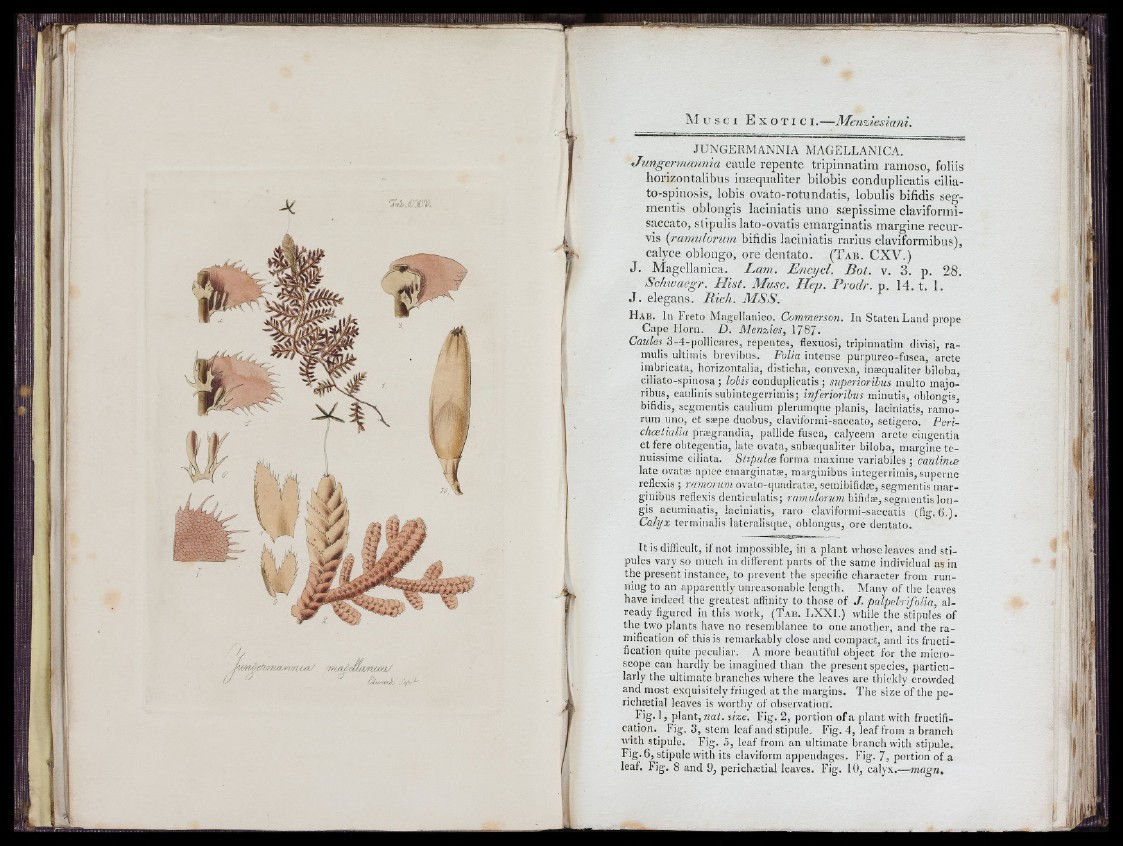
JUNGERMANNIA MAGELLANICA.
Jungermannia caule repente tripinnatiin ramoso, foliis
horizontalibus inæqnaliter bilobis conduplicatis cilia-
to-spinosis, lobis ovato-rotundatis, lobulis bifidis segmentis
oblongis laciniatis uno sæpissime claviformi-
saccato, stipulis lato-ovatis emarginatis margine recurvis
(ramidorum bifidis laciniatis rarins claviformibus),
calyce oblongo, ore dentato. (Tab. CXV.)
J. Magellanica. Lam. Encycl. Bot. v. 3. p. 28.
Schivacgr. Hist. Musc. Hep. Prodr. p. 14. t. 1.
J . elegans. Rich. M S S .
H ab. lu Freto Magellanico. Commerson. In Stateu Land prone
Cape Horn. D. Menzies, 1787.
Caules 3-4-pollicares, repentes, flexuosi, tripinnatim divisi, ra-
inulis ultimis brevibus. Folia intense purpureo-f'usca, arcte
imbricata, horizontalia, disticha, convexa, inæqualiter biloba,
ciliato-spinosa ; lohis conduplicatis; superioribus multo majo-
ribiis, caulinis subintegerrimis; inferiorihus minutis, oblongis,
bifidis, segmentis cauliurn plerumque plants, laciniatis, ramorum
uno, et sæpe duobus, claviformi-saccato, setigero. Peri-
choeliülïa prægrandia, pallide fusca, calycem arcte cingentia
et fere obtegentia, late ovata, subæqualiter biloba, margine tenuissime
cibata. Stipulæ forma ma.xime variabiles ; caulïnoe
late ovatæ apice emarginatæ, margiiiibus integerrimis, superne
reflexis ; ramorum ovato-quadratæ, seniibifidæ, segmentis marginibus
reflexis dentieiilatis; ramulomm bifidæ, segmentis longis
acuminatis, laciniatis, raro claviformi-saccatis (iìg. (j,).
Calyx terminalis lateralisque, oblongus, ore dentato.
It is difficult, if not impossible, in a plant whose leaves and stipules
vary so much in different parts of the same individual as in
the present instance, to prevent the specific character from running
to an apparently unreasonable length. Many of the leaves
have indeed the greatest affinity to those of J. palpehrifolia, already
figured in this work, (Tab. LXXI.) while the stipules of
the two plants have no resemblance to one another, and the ramification
of this is remarkably close and compact, and its fructification
quite peculiar. A more beautiful object for the microscope
can hardly be imagined than the present species, particularly
the ultimate branches where the leaves are tiiickly crowded
and most exquisitely fringed at the margins. I ’he size of the perichaetial
leaves is wortliy of observation.
Fig. 1, plant, nat. size. Fig. 2, portion of a plant with fructification.^
Fig. 3, stem leaf and stijmle. Fig. 4, leaf from a branch
with stipule. Fig. 5, leaf from an ultimate branch with stipule.
Fig. 6, stipule with its claviform appendages. Fig. 7, portion of a
leaf. Fig. S and 9, perichætial leaves. Fig. 10, calyx.—magn.
I!
iiii